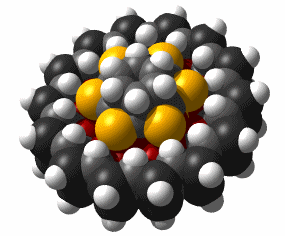Stroboscopic illusion in animations of diamondoid molecular machine elements
Thermal motions are in the km/second speed range.
Machine motions are in the mm/s to m/s speed range.
Contents
[hide]Beware of the stroboscopic illusion
| well animated bearing The fast thermal vibrations are more realistically blurred out. The remaining localized periodic average deformations (visible here if one looks closely) are highly reversible. (See page abbout "superlubrication".) |
badly animated bearing The present stroboscopic effect can be misleading in that friction is likely to be grossly overestimated. It deceivingly looks like as if the operating speed would be close to the speed of the thermal vibration. If that where the case it indeed would cause massive friction (strong coupling of motions with similar frequency). |
Simulated DMEs often show a misleading stroboscopic effect which can make one believe that the operation frequencies lie near the thermal frequencies, giving the false impression of enormously high friction but actually the contrary is true.
See: "Friction in gem-gum technology" and "Superlubrication".
(wiki-TODO: pack the above in a template so I can put it on this page, the crytolecule main page, and the crystolecule example page)
Proposed speeds vs simulated speeds
In nanosystems proposed speeds are around 5mm/s for productive nanomachinery (around 1MHz for molecular mills).
No wobbly rubber/jelly like behavior at proposed "normal" speeds.
At these proposed speeds diamond behaves hard and stiff just like one would expect at the macroscale.
See: Same relative deflections across scales.
Only thermal motions cause notable flex for the very smallest parts but
mechanical crashes don't perceptibly contribute to that.
Due to time-steps needing to be smaller than the time of atomic wiggles.
In molecular dynamics the simulated speeds are typically in a range between 10m/s and 100m/s or even more.
(Nearing the unsupported rotating ring speed limit at ~3km/s.)
Rubber wobbly/jelly like behavior at NOT proposed but simulated "abnormal" speeds.
At these speeds flawless diamond crystolecules starts to behave like rubber. Showing superelasticity.
But this may be a bit misleading. Massive flex like this is not something to expect in normal operations at way way slower (proposed) speeds.
Massive static deformations of that magnitude may be present at "normal" speeds but may also be better avoided due to associated dissipation mechanisms.
See: Entropomechanical converter & Accidental heatpump.
Exorbitant friction levels at NOT proposed but simulated "abnormal" speeds.
These simulated speeds are between a thousand an a million times faster than the proposed speeds.
And with dynamic friction scaling by square the friction at these speeds would be
between a million (106) and a trillion (1012) times higher.
More accurately things become hard to predict when coming in resonances with higher energy phonon modes.
A bulk volume of these nanomachines running steady state at these extreme speeds
would not be actively coolable fast enough even by advanced means.
Crystolecular machine elements can only be operated at these extreme speeds in two special cases (if at all):
- A single lone nanomachine well coupled to bulk diamond not creating heat but just conducting it away
Higher surface area per volume at nanoscale helps a lot for rapid cooling. - A bulk volume of nanomachinery but only for a very short pulse in time using the heat capacity of the same material as a temporary buffer averting the need for heat conduction all-together.
Related
- Misleading aspects in animations of diamondoid molecular machine elements
- Superlubricity
- Snapback
- Gemstone-like molecular element
- Example crystolecules
- Common critique towards diamondoid atomically precise manufacturing and technology
External links
- Wikipedia: Wagon-wheel effect

